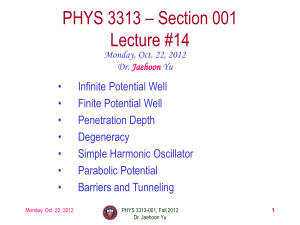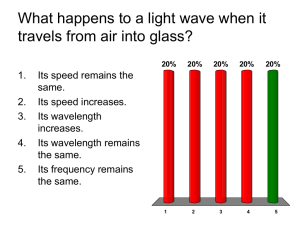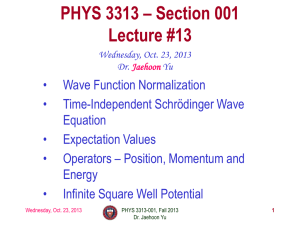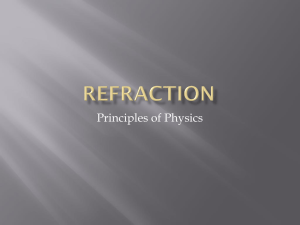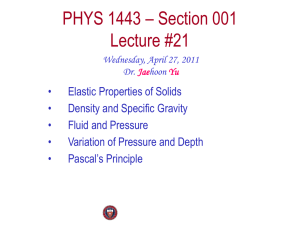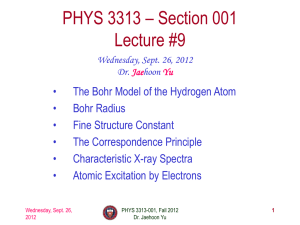phys1442-summer13-070313
advertisement
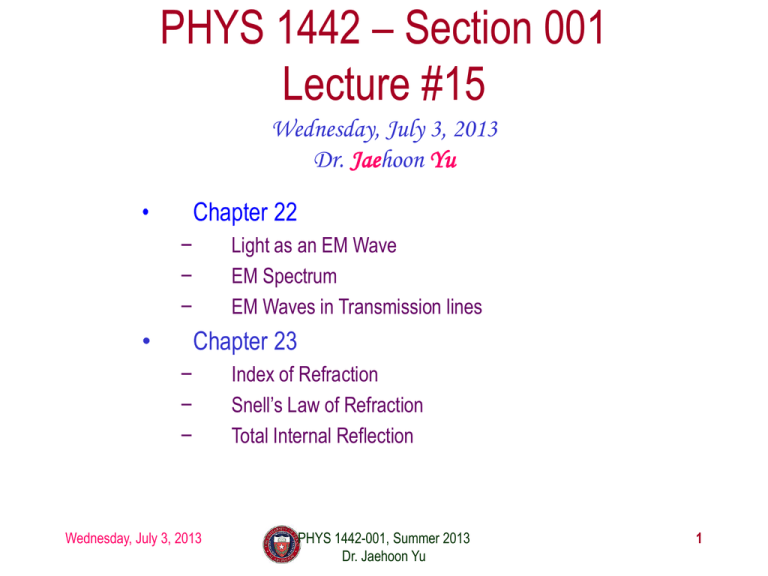
PHYS 1442 – Section 001 Lecture #15 Wednesday, July 3, 2013 Dr. Jaehoon Yu • Chapter 22 Light as an EM Wave EM Spectrum EM Waves in Transmission lines − − − Chapter 23 • − − − Wednesday, July 3, 2013 Index of Refraction Snell’s Law of Refraction Total Internal Reflection PHYS 1442-001, Summer 2013 Dr. Jaehoon Yu 1 Announcements • Final exam – Comprehensive exam • Covers CH16.1 – what we finish today plus Appendices A1 – A8 – 10:30am – 12:30pm, Monday, July 8 – Please do not miss this exam! • You will get an F if you miss it! – BYOF with the same rules as before • Your planetarium extra credit – Please bring your planetarium extra credit sheet by the beginning of the exam Monday, July 8 – Be sure to tape one edge of the ticket stub with the title of the show on top and your name on the sheet Wednesday, July 3, 2013 PHYS 1442-001, Summer 2013 Dr. Jaehoon Yu 2 Light as EM Wave • People knew some 60 years before Maxwell that light behaves like a wave, but … – They did not know what kind of wave it is. • Most importantly what is it that oscillates in light? • Heinrich Hertz first generated and detected EM waves experimentally in 1887 using a spark gap apparatus – Charge was rushed back and forth in a short period of time, generating waves with frequency about 109Hz (these are called radio waves) – He detected using a loop of wire in which an emf was produced when a changing magnetic field passed through – These waves were later shown to travel at the speed of light Wednesday, July 3, 2013 PHYS 1442-001, Summer 2013 Dr. Jaehoon Yu 3 Light as EM Wave, cnt’d • The wavelengths of visible light were measured in the first decade of the 19th century – The visible light wavelengths were found to be between 4.0x10-7m (400nm) and 7.5x10-7m (750nm) – The frequency of visible light is from fλ=c • Where f and λ are the frequency and the wavelength of the wave – What is the range of visible light frequency? – 4.0x1014Hz to 7.5x1014Hz • c is 3x108m/s, the speed of light • EM Waves, or EM radiation, are categorized using EM spectrum Wednesday, July 3, 2013 PHYS 1442-001, Summer 2013 Dr. Jaehoon Yu 4 Electromagnetic Spectrum • Low frequency waves, such as radio waves or microwaves can be easily produced using electronic devices • Higher frequency waves are produced through natural processes, such as emission from atoms, molecules or nuclei • Or they can be produced from acceleration of charged particles • Infrared radiation (IR) is mainly responsible for the heating effect of the Sun – The Sun emits visible lights, IR and UV • The molecules of our skin resonate at infrared frequencies so IR is preferentially absorbed and thus warms up our body Wednesday, July 3, 2013 PHYS 1442-001, Summer 2013 Dr. Jaehoon Yu 5 Example 22 – 1 Wavelength of EM waves. Calculate the wavelength (a) of a 60-Hz EM wave, (b) of a 93.3-MHz FM radio wave and (c) of a beam of visible red light from a laser at frequency 4.74x1014Hz. What is the relationship between speed of light, frequency and the wavelength? cf Thus, we obtain c f For f=60Hz For f=93.3MHz For f=4.74x1014Hz Wednesday, July 3, 2013 3 108 m s 5 106 m 60s 1 3 108 m s 6 1 93.3 10 s 3 108 m s 3.22m 6.33 107 m 4.74 1014Summer s 12013 PHYS 1442-001, Dr. Jaehoon Yu 6 EM Wave in the Transmission Lines • Can EM waves travel through a wire? – Can it not just travel through the empty space? – Yes, it sure can travel through a wire. • When a source of emf is connected to a transmission line, the electric field within the wire does not get set up immediately at all points along the line – When two wires are separated via air, the EM wave travel through the air at the speed of light, c. – However, through medium w/ permittivity and permeability , the speed of the EM wave v =is1given em c • Is this faster than c? Wednesday, July 3, 2013 Nope! It is slower. PHYS 1442-001, Summer 2013 Dr. Jaehoon Yu 7 Energy in EM Waves • Since B=E/c and c 1 0 0 , we can rewrite the energy 2 density 2 E 1 1 2 0 0 2 u E 0 0 E u uE uB 0 E 2 0 2 – Note that the energy density associate with B field is the same as that associate with E field – So each field contributes half to the total energy of the EM wave • By rewriting using B field only, we obtain 2 2 2 1 B 1B B u 0 2 0 0 2 0 0 u B2 0 • We can also rewrite to contain both E and B 0 u 0 E 0 EcB EB 0 0 0 2 •Wednesday, July 3, 2013 0 EB PHYS 1442-001, Summer 2013 Dr. Jaehoon Yu 0 u EB 0 8 Energy Transport • What is the energy the wave transport per unit time per unit area? – This is given by the vector S, the Poynting vector • The unit of S is W/m2. • The direction of S is the direction in which the energy is transported. Which direction is this? – The direction the wave is moving • Let’s consider a wave passing through an area A perpendicular to the x-axis, the axis of propagation – How much does the wave move in time t? = – The energy that passes through A in time t is the energy that occupies the volume V, DV =ADx = AcDt – Since the energy density is u=0E2, the total energy, U, contained in the volume V isDU = uDV = E 2 AcDt 0 Wednesday, July 3, 2013 PHYS 1442-001, Summer 2013 Dr. Jaehoon Yu 9 Energy Transport • Thus, the energy crossing the area A per time t is 1 DU S= = e 0 cE 2 A Dt • Since E=cB and c 1 0 0 , we can also rewrite S 0 cE 2 cB 2 0 EB 0 • Since the direction of S is along v, perpendicular to E and B, the Poynting vector S can be written 1 S= E´B m0 ( ) – This gives the energy transported per unit area per unit time at any instant Wednesday, July 3, 2013 PHYS 1442-001, Summer 2013 Dr. Jaehoon Yu 10 Average Energy Transport • The average energy transport in an extended period of time since the frequency is so high we do not detect the rapid variation with respect to time. • If E and B are sinusoidal, E 2 = E02 2 • Thus we can write the magnitude of the average Poynting vector as 1 1 c 2 E0 B0 2 S 0 cE0 B0 2 2 0 2 0 – This time averaged value of S is the intensity, defined as the average power transferred across unit area. E0 and B0 are maximum values. • We can also write S Erms Brms 0 – Where Erms and Brms are the rms values ( Erms Wednesday, July 3, 2013 PHYS 1442-001, Summer 2013 Dr. Jaehoon Yu E 2 , Brms B 2 ) 11 Example 22 – 4 E and B from the Sun. Radiation from the Sun reaches the Earth (above the atmosphere) at a rate of about 1350W/m2. Assume that this is a single EM wave and calculate the maximum values of E and B. What is given in the problem? The average S!! 1 c 2 E0 B0 1 2 B0 S 0 cE0 2 0 20 2 2S For E0, E0 0c For B0 8.85 10 2 1350 W m2 12 C 2 N m2 3.00 108 m s 1.01 103 V m E0 1.01 103 V m 6 B0 3.37 10 T 8 c 3 10 m s Wednesday, July 3, 2013 PHYS 1442-001, Summer 2013 Dr. Jaehoon Yu 12 Index of Refraction • Index of refraction of a material is defined as: – The inverse of the relative of speed light in a material • Index of refraction of vacuum is 1.0000, and that of air is 1.0003 • – So mathematically, one would define it as c n= v What is the refraction? – The phenomena that the direction of light changes when it passes through the boundary of two transparent materials whose indices of refraction are different – How is this different than reflection? Wednesday, July 3, 2013 PHYS 1442-001, Summer 2013 Dr. Jaehoon Yu 13 Example 23 – 5 Speed of Light in Diamond. Calculate the speed of light in diamond. What is the relationship between speed of light and the index of refraction? c n= v Index of refraction of diamond is, from table 23 -1 n = 2.42 So the speed of light in diamond is 3´ 108 c c 8 v= = = 1.24 ´ 10 m s = 0.413c = 2.42 n 2.42 Wednesday, July 3, 2013 PHYS 1442-001, Summer 2013 Dr. Jaehoon Yu 14 Refraction cont’d • When refraction occurs, it normally comes with a partial reflection of the light • The refracted light bends towards the normal incident plane when the index of refraction changes from small to large • The refracted light bends away from the normal incident plane if the index of refraction changes from large to small • θ1: Angle of Incidence • θ2: Angle of refraction Wednesday, July 3, 2013 PHYS 1442-001, Summer 2013 Dr. Jaehoon Yu 15 Snell’s Law of Refraction • The angle of refraction depends on the speed of light in the two media and the incident angle. • Willebrord Snell analytically derived the relationship between the angle of incidence and refraction in 1621 n1 sin q1 = n2 sin q 2 • This is the basic Law of Refraction • Does this law explain the bend angles we discussed in the previous page? Wednesday, July 3, 2013 PHYS 1442-001, Summer 2013 Dr. Jaehoon Yu 16 Example 23 – 6 Refraction through flat glass. Light travels through a uniformly thick glass at an incident angle of 60o as shown in the figure. If the index of refraction of the glass is 1.5, (a) what is the angle of refraction A in the glass and (b) what is the light’s emerging angle B? (a) From Snell’s law, we obtain n1 sin q1 = nA sin q A sin q A = n1 sin q1 1.0 × sin 60 = = 0.577 nA 1.5 q A = sin -1 ( 0.577 ) = 35.2 (b) Again from Snell’s law, we obtain nA sin q A = n1 sin q B nA sin q A 1.5×sin 35.2 1.5×0.577 = sin q B = = = 0.866 n1 1.0 1.0 The lights comes out at the same angle as it -1 q A = sin 0.866 = 60 went in. The image will look shifted slightly. ( Wednesday, July 3, 2013 ) PHYS 1442-001, Summer 2013 Dr. Jaehoon Yu 17 Total Internal Reflection • What happens when the light passes through the boundary of two media from larger index of refraction to smaller one? – Right… It bends away from the normal incident plane – And has some partial reflections • But when the incident angle is above certain value, the entire light reflects back into the first medium n2 n2 o sin q c = sin 90 = n1 n1 • This phenomena is called the total internal reflection Wednesday, July 3, 2013 PHYS 1442-001, Summer 2013 Dr. Jaehoon Yu Can total internal reflection happen in all cases? Nope. Then when can it? When the light enters from larger to smaller index of refraction material. 18 Conceptual Problem Total Internal Refl. • View up from under water: What do you think a person would see if she looks up from beneath the undisturbed perfectly smooth surface of water? What is the critical angle for air-water interface? The person will see the world compressed in a circle that forms a 49o angle relative to the eyes. Beyond that angle, she will see the bottom of the pool. Wednesday, July 3, 2013 n2 1.0 = 0.75 = sin q c = n1 1.33 qc = sin-1 ( 0.75) = 49 PHYS 1442-001, Summer 2013 Dr. Jaehoon Yu 19 Total Internal Reflection Devices • Glass Prisms: What should the angle of the prisms be for total internal reflection? 41.8o • Fiber optic cables: glass or plastic fibers with a few μm diameter. How do you think it works? Light signal gets carried through the fiber with virtually no loss since the incident angle is larger than the critical angle! Wednesday, July 3, 2013 Some cables can carry up to 1 Tera bit/sec information!! PHYS 1442-001, Summer 2013 Dr. Jaehoon Yu 20 Congratulations!!!! You have survived me!! You all have have been fantastic!!! I am truly proud of you! Good luck with your exam!!! Have a great and safe summer!! Wednesday, July 3, 2013 PHYS 1442-001, Summer 2013 Dr. Jaehoon Yu 21

